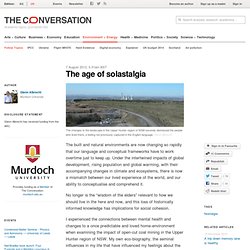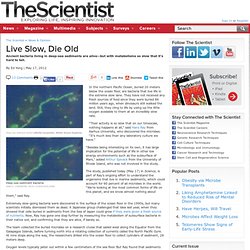

The age of solastalgia. The built and natural environments are now changing so rapidly that our language and conceptual frameworks have to work overtime just to keep up.

Under the intertwined impacts of global development, rising population and global warming, with their accompanying changes in climate and ecosystems, there is now a mismatch between our lived experience of the world, and our ability to conceptualise and comprehend it. No longer is the “wisdom of the elders” relevant to how we should live in the here and now, and this loss of historically informed knowledge has implications for social cohesion. I experienced the connections between mental health and changes to a once predictable and loved home-environment when examining the impact of open-cut coal mining in the Upper Hunter region of NSW.
By the late 1990s the extent of open-cut coal mining in the Upper Hunter was in excess of 500 square kilometres and had changed the landscape in ways that older traditions of underground mining did not. Science.nasa.gov/media/medialibrary/2010/03/31/EarthDayBooklet.pdf. Live Slow, Die Old. Ancient bacteria living in deep-sea sediments are alive—but with metabolisms so slow that it’s hard to tell.

Deep-sea sediment bacteriaShelly Carpenter, NOAA Ocean Explorer Deep-sea sediment bacteriaSHELLY CARPENTER, NOAA OCEAN EXPLORER In the northern Pacific Ocean, buried 20 meters below the ocean floor, are bacteria that live life in the extreme slow lane. They have not received any fresh sources of food since they were buried 86 million years ago, when dinosaurs still walked the land. Still, they cling to life by using up the little oxygen available to them at an incredibly slow rate. “Their activity is so slow that on our timescale, nothing happens at all,” said Hans Røy from Aarhus University, who discovered the microbes. “Besides being interesting on its own, it has large implication for the potential of life in other low energy environments such as the subsurface of Mars,” added Arthur Spivack from the University of Rhode Island, who was not involved in the study.
TERRESTRIAL ECOLOGY. MARINE SCIENCE/OCEANOGRAPHY. Wong Ee Lynn - Volunteering with her Heart : EcoKnights.org.my - Inspiring Sustainable Living. Volunteering is generally considered an altruistic activity, intended to promote good or improve human quality of life, but people also volunteer for their own skill development, to meet others, to make contacts for possible employment, to have fun, and a variety of other reasons that could be considered self-serving.

Volunteerism is the act of selflessly giving your life to something you believe free of pay. Although if a person volunteers they may not earn money, it produces a feeling of self-worth and volunteers earn respect and Favors instead of money. Volunteering takes many forms and is performed by a wide range of people. Many volunteers are specifically trained in the areas they work in, such as medicine, education, or emergency rescue. Other volunteers serve on an as-needed basis, such as in response to a natural disaster or for a beach-cleanup. Ee Lyn is a lawyer by training but left a career in legal practice in 2009 to work as a fulltime humanitarian service professional.
Videos. Literature. SCIENTIFIC PAPERS. PRESS ARTICLES.